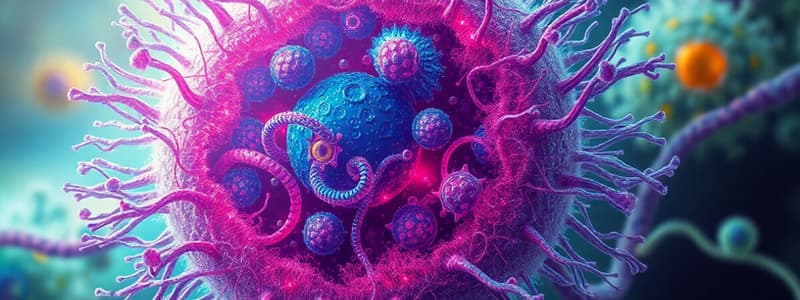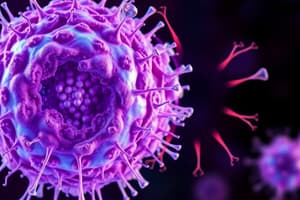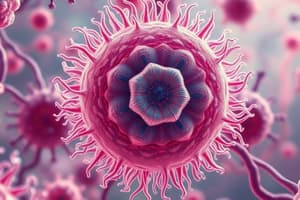Podcast
Questions and Answers
What is the field of biology that has practical applications in medicine and healthcare?
What is the field of biology that has practical applications in medicine and healthcare?
Medical Biology
What is the basic unit of life?
What is the basic unit of life?
The cell
What are the two types of organisms based on the number of cells?
What are the two types of organisms based on the number of cells?
Unicellular and multicellular organisms
Unicellular organisms are capable of performing the essential functions of life.
Unicellular organisms are capable of performing the essential functions of life.
The cell wall is a unique characteristic of animal cells.
The cell wall is a unique characteristic of animal cells.
The cell theory states that all living organisms are composed of cells and products of cells.
The cell theory states that all living organisms are composed of cells and products of cells.
Which of the following scientists made the discovery of the nucleus within the cell?
Which of the following scientists made the discovery of the nucleus within the cell?
What is the function of the nucleus?
What is the function of the nucleus?
What type of cells have membrane-bound nuclei?
What type of cells have membrane-bound nuclei?
What is the semi-fluid matrix that occupies the volume of a cell?
What is the semi-fluid matrix that occupies the volume of a cell?
Which of the following organelles are found in both eukaryotic and prokaryotic cells?
Which of the following organelles are found in both eukaryotic and prokaryotic cells?
Prokaryotic cells lack membrane-bound organelles.
Prokaryotic cells lack membrane-bound organelles.
Cells are all the same size and shape.
Cells are all the same size and shape.
What are the four basic shapes of bacteria?
What are the four basic shapes of bacteria?
Plant cells have centrioles.
Plant cells have centrioles.
What are the two main types of cells?
What are the two main types of cells?
Flashcards
What is Oral Biology?
What is Oral Biology?
The branch of dentistry focused on the study of prenatal and postnatal growth (embryology), oral physiology, anatomy, histology, and development, with a special emphasis on teeth and surrounding tissues (enamel, dentin, pulp, periodontium) and structures outside the mouth (salivary glands, temporomandibular joint).
What is Medical Biology?
What is Medical Biology?
A field of human biology that deals with the practical application of human biology in medicine, healthcare, and laboratory diagnosis. It's the study of humans and their populations from a biological perspective.
What is a cell?
What is a cell?
The fundamental structural and functional unit of all living organisms. Any structure smaller than a complete cell cannot function independently, making the cell the basic building block of life.
Cell Theory
Cell Theory
Signup and view all the flashcards
What is cytoplasm?
What is cytoplasm?
Signup and view all the flashcards
What are eukaryotic cells?
What are eukaryotic cells?
Signup and view all the flashcards
What are prokaryotic cells?
What are prokaryotic cells?
Signup and view all the flashcards
What is the cell membrane?
What is the cell membrane?
Signup and view all the flashcards
What is the nucleus?
What is the nucleus?
Signup and view all the flashcards
What are ribosomes?
What are ribosomes?
Signup and view all the flashcards
What is the endoplasmic reticulum (ER)?
What is the endoplasmic reticulum (ER)?
Signup and view all the flashcards
Golgi complex
Golgi complex
Signup and view all the flashcards
Lysosomes
Lysosomes
Signup and view all the flashcards
Mitochondria
Mitochondria
Signup and view all the flashcards
Microbodies
Microbodies
Signup and view all the flashcards
Vacuoles
Vacuoles
Signup and view all the flashcards
Centrosome
Centrosome
Signup and view all the flashcards
What is the cell wall?
What is the cell wall?
Signup and view all the flashcards
Plastids
Plastids
Signup and view all the flashcards
Characteristics of prokaryotic cells
Characteristics of prokaryotic cells
Signup and view all the flashcards
Characteristics of eukaryotic cells
Characteristics of eukaryotic cells
Signup and view all the flashcards
Cell variation in size, shape, and function
Cell variation in size, shape, and function
Signup and view all the flashcards
Cellular size
Cellular size
Signup and view all the flashcards
Bacterial shapes
Bacterial shapes
Signup and view all the flashcards
Unique features of plant cells
Unique features of plant cells
Signup and view all the flashcards
Unique features of animal cells
Unique features of animal cells
Signup and view all the flashcards
Study Notes
Introduction of Medical & Oral Biology (First Stage)
- This lecture introduces medical and oral biology.
- The outline topics include: what oral biology is, medical biology, the cell, the cell theory, an overview of the cell, and types of cells.
What is Oral Biology?
- Oral biology is a branch of dentistry.
- It studies embryology (prenatal and postnatal growth), oral physiology, gross anatomy, histology, and development.
- Key focus is on dental hard and soft tissues (enamel, dentin, pulp, and periodontium) and extraoral structures like salivary glands and TMJ.
Medical Biology
- Medical biology is a field of human biology.
- It has applications in medicine, healthcare, and laboratory diagnostics.
- It studies human beings and populations from a biological perspective.
- Biology is the science of all living things and their environments.
What is the Cell?
- Cells are the basic units of life.
- Organisms are composed of cells.
- Unicellular organisms consist of a single cell and perform all life functions independently.
- Multicellular organisms are composed of many cells.
- Cells are the fundamental structural and functional units of all living organisms.
Theory of the Cell
- 1838: Matthias Schleiden (botanist) observed plants are made of cells.
- 1839: Theodore Schwann (zoologist) observed similar cell structures in animals.
- Together they proposed a cell theory, but it did not yet explain how new cells form.
- 1855: Rudolf Virchow corrected the theory stating all cells arise from pre-existing cells (omni cellula e cellula).
- Modern cell theory: All living organisms are composed of cells and cell products; all cells come from pre-existing cells.
An Overview of the Cell
- Cells vary greatly in size, shape, and activity.
- Mycoplasmas are the smallest cells (0.3 µm) while some cells are large (ostrich egg).
- Human red blood cells are roundish, other cells are polygonal, columnar, cuboid, thread-like, or irregular.
- The cell shape often reflects the function it performs.
- Cells have an outer membrane that delimits the cell.
- Inside the membrane is cytoplasm, a semi-fluid matrix of cellular activities.
Types of the Cell
-
Prokaryotic Cells: bacteria, blue-green algae, mycoplasma, PPLO.
- Generally smaller than eukaryotic cells.
- Reproduce rapidly
- They have a simple structure with no membrane-bound organelles.
- Four basic shapes: bacillus (rod-like), coccus (spherical), vibrio (comma-shaped), and spirillum (spiral).
-
Eukaryotic Cells: protists, plants, animals, fungi.
- Larger and more complex than prokaryotic cells.
- Compartmentalized cytoplasm with membrane-bound organelles.
- Cells organized nucleus with genetic material organized in chromosomes.
- Unique characteristics like cell walls, plastids and/or a large central vacuole (plant cells)
- Animal cells have centrioles that are absent in most plant cells.
-
Organelles in eukaryotic cells: endoplasmic reticulum, Golgi complex, lysosomes, mitochondria, microbodies, ribosomes, vacuoles.
-
Ribosomes are found in all cells, prokaryotic and eukaryotic.
- Found in the cytoplasm, but also within chloroplasts, mitochondria, and on rough ER.
Studying That Suits You
Use AI to generate personalized quizzes and flashcards to suit your learning preferences.




